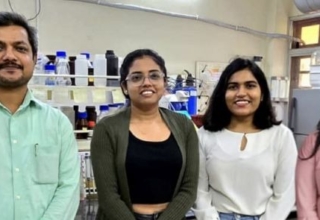
Today, colour trends in fashion and design include sparkling hues like holographic, pearlescent, and iridescent effects. Also, there is a cost to the environment. This development is a solution to the problem by using renewable resources like sugarcane bagasse
IIT Roorkee researchers have developed structural colour-based sensors by making structural colour from an unexpected natural resource–agro-waste sugarcane bagasse. It is a structural colour-based stimulus-responsive sensor from Nano-cellulose having implications in intelligent packaging.
This is the first demonstration of a photonic film having potential as a candidate material having implications in bio-optical engineering and intelligent packaging. The composite films displayed good visual colour-sensing properties with moderate antibacterial activity for Escherichia coli bacteria. The research work has been published recently in ACS Applied Nano Materials (https://doi.org/10.1021/acsanm.2c05177).
The colour of the laminated films comes from a ‘chiral nematic liquid crystal,’ a specific molecular self-assembly that interacts selectively with specific colours of visible light. Prof Pradip K Maji at the Department of Polymer and Process Engineering, who led this team emphasized that these sensing chips developed with an agro-waste-derived product show a dramatic change of reflection colour toward particular stimuli.
One of the important structural components obtained from sugarcane bagasse is cellulose. Precisely, cellulose nanocrystal competes as the most relevant raw material to imitate natural structural-based colouration. Also, the nanocellulose suspension is non-toxic and produced from readily available natural material, and is highly suitable for upscaling. The bagasse must first be ground into tiny microscopic fragments called cellulose nanocrystals to make this structural colour film. This process is divided into stages of bleaching raw fibre and acid hydrolysis of cellulose pulp under standardized conditions. The final CNC suspension is then concentrated to make it behave as a liquid crystal material showing amazing birefringence (splitting of light) properties.
Chhavi Verma, the lead author of the work, added that, as a team, they were marching ahead to their set goals of sustainability to make the structural colouration approach feasible and commercially available, thus reducing the use of chemically based dyes and pigments.
Prof Pradip K Maji, Department of Polymer and Process Engineering, IIT Roorkee, highlighted, “The prepared sensors generate different colours in response to chemical stimuli and are very thin films, meaning minimal material is used. These films were further interlocked between layers of biopolymers to form a laminated structure having robust mechanical stability for intelligent packaging applications.”
Prof. K K Pant, Director, IIT Roorkee acknowledged the idea and said, “As pressure mounts for environmentally friendly products and services, the demand for eco-friendly packaging alternatives has skyrocketed. This approach to developing an environmentally friendly bio-inspired product can potentially act as a substitute to synthetic sensors.”










